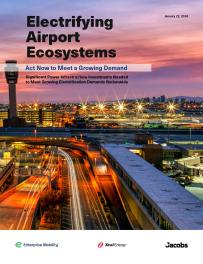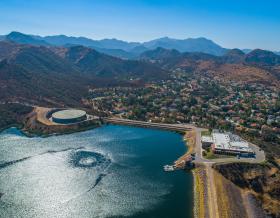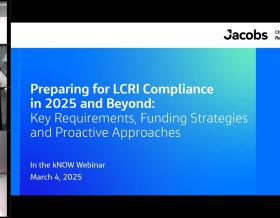
According to Airports Council International, 2.3 billion passengers were welcomed by European airports in 2023, showing a surge of over 19% compared to 2022 and just 5% below pre-pandemic volumes. These rising numbers directly affect revenue for those airports and host countries: research by the European Commission reveals that aviation directly contributes more than €110 billion to the European GDP.
It's not just about rising passenger numbers and revenue: airports are vital links in busier supply chains locally and across national borders. As with most major industries, airports are also working on decarbonization strategies, especially regarding electrification and low-carbon fuel sources, as they are key catalysts for net-zero progress. Decarbonization in aviation is a complex, intricate challenge, as airports are aiming to decarbonize everything at pace within the wider context of the rapid evolution of flight and air travel.
While the maturity and success of these strategies vary across Europe, there is one common theme: airports and related services are electrifying, increasing the impact on the power grid and driving the need for infrastructure investment. It also aligns with a sharp rise in electric vehicles in Europe — the sales are forecasted to double from 2025 to 2030, and that's without accounting for keen pricing decreases due to lower future costs of lithium-ion batteries. Combine this with the increase in electric taxis and electric vehicle (EV) private fleets that serve airports and airside vehicles (tugs, luggage vans and similar), and the airport power needs dramatically increase.
While most of the major European airports are already working on energy transition and decarbonization strategies, most of the wider airport ecosystems aren’t aware of the rising power needs but are sharing the same energy grid. Crucially, these stakeholders and partners aren’t working together to effectively plan and adapt the energy grids for future success.
All these electrification factors point to a rising demand for power derived from renewable sources as per COP28 pledges and guidelines, and it's being emphasized in global research. Electrifying Airport Ecosystems, a new study from Enterprise Mobility, Xcel Energy and Jacobs, aims to raise awareness of the significant power infrastructure investments needed to support electrification in airport ecosystems nationwide.
One of the key takeaways from the report is that by 2030, electrifying airport ecosystems will nearly double their current peak power demands, and by 2050, they could require almost five times the existing electric power use. Steve Pelham, vice president of aviation for the Americas at Jacobs, aptly described how electrifying the rental car section at airports is the ‘canary in the gold mine’ in emphasizing the need to upgrade power grids.
Providing a European context
As airports serve as the key transport and supply hubs within our cities, they require stakeholder engagement and cross-sector collaboration to help solve the question of future power demand and supply. This challenge affects private and public priorities and the needs of the airports' communities, so a collective effort is required. The next steps require significant investment and large-scale power infrastructure projects, which take around seven years to complete.
Operational resiliency is at the top of the European airport priority list and net-zero carbon road maps. It relies on overcoming the challenge of getting power from the network to the airport. Microgrids and distributed energy resources (DER) are critical ingredients in the short-term solution; however, they need to be integrated into a long-term strategy. This research report affirms the importance of power for ground vehicles, but the findings must be paired with a focus on airside and aircraft solutions, such as zero-carbon emission flights and hydrogen fuel, along with plans for heat decarbonization and scope 1, 2 and 3 emissions for a combined decarbonization strategy.
Safely planning the next steps to meet European demand
To ensure that the right investments are made at the right time, airports require a master planning approach that relies on an ecosystem view with careful stakeholder integration. Lessons from the Electrifying Airports Ecosystem report will also influence these next steps. In Passenger Terminal World, we also highlighted a new master planning approach that will guide future steps.
One of the most important lessons is finding the right partners with track record insights that understand the airport ecosystem to empower effective stakeholder engagement and collaboration. Those partnerships will help unlock the next three steps:
- Create a layered, data-driven infrastructure investment plan.
By factoring in the right long-term strategy and stakeholder business transition plans, the airport owners can safely and incrementally develop the power infrastructure with less disruption to supply chains and local communities. This requires whole systems thinking to include the broader ecosystem.
- Integrate lessons and capabilities from other sectors.
Take a lessons-learned approach and recruit expertise from sectors such as energy and power and the rest of transport to help solve the questions of power demand and sourcing. The energy transition decisions needed now are critical enablers of commercial resilience and success in decarbonization. Airports must get ahead of the energy challenges, including grid utilities and transmission infrastructure, to ensure the short-term risks don’t become long-term barriers to growth. This requires in-depth economic modeling and cost-benefit analysis to show the return on infrastructure investment in the short term and may require new P3 funding models with regional authorities included.
- Rely on industry collaboration and iterative innovation.
Find and partner with key stakeholders, such as the example of rental car companies in the research report, to help drive program momentum and share best practice. There should also be constant investment in innovation, both in terms of money and time. Case in point: Jacobs is investing in the latest onsite renewable power generation, such as turbines and panels along with microgrid options to help drive positive change on behalf of the industry. We're also leading a critical workstream within Heathrow's Carbon & Sustainability Program (CSP), which makes use of a Jacobs-developed, bespoke marginal abatement cost curve (MACC) analysis tool to evaluate the integration of financial investment and tonnes of carbon (£/tCO2e) saved over the project lifetime. This helps provide assurance on the effectiveness of capital investment.
Using data-driven insights and the right partners to build resilience
The cost of infrastructure investment is high, but focusing on the value outlined by stakeholders and end customers can offer long-term benefits of power stability, resilience and social value. These future airports will offer better mobility, cleaner air, more employment and economic growth, and help make immediate communities and cities more prosperous.
The key to making this happen in Europe is finding the right partners, working on stakeholder engagement, and defining these tiered power infrastructure frameworks as soon as possible.
“With the recovery of air travel and projected growth, there will be exponential growth in electricity demand (doubling by 2030 at most airports). To meet this demand, we need whole systems thinking to consider the wider airport ecosystems. This will empower us to make timely, low or no-regret infrastructure investment decisions to meet targets and objectives. The findings in reports such as this will help define the roadmap for collective global success.”
About the author
After graduating with a master’s degree in business in aviation from Embry-Riddle Aeronautical University, Jacobs Regional Aviation Leader for U.K., Europe and the Middle East, Cheryl McNall has worked internationally in aviation for over 18 years and has experience in all facets of aviation infrastructure through an airport planning, design and major program delivery lens.
Cheryl has led and empowered some of the most dynamic teams in the industry, both as a consultant and a client at the busiest airports and mega-programs globally. As a pioneering problem solver, she has developed and delivered tailored solutions that offer a signature blended array of technical capabilities across infrastructure, investment, digital, sustainability and energy.
Electrifying Airport Ecosystems
Significant Power Infrastructure Investments Needed to Meet Growing Electrification Demands Nationwide

Airports are major economic drivers, contributing to more than seven percent of the United States’ (U.S.) gross domestic product in 2023. Airports and related services are also rapidly electrifying. The growth in electricity demand – and the time required to build power infrastructure to deliver it – means there is significant work to be done now to prepare for the future.
Electrifying Airport Ecosystems, a new study from Enterprise Mobility, Xcel Energy and Jacobs, aims to raise awareness of the significant power infrastructure investments needed to support electrification in airport ecosystems nationwide.













































